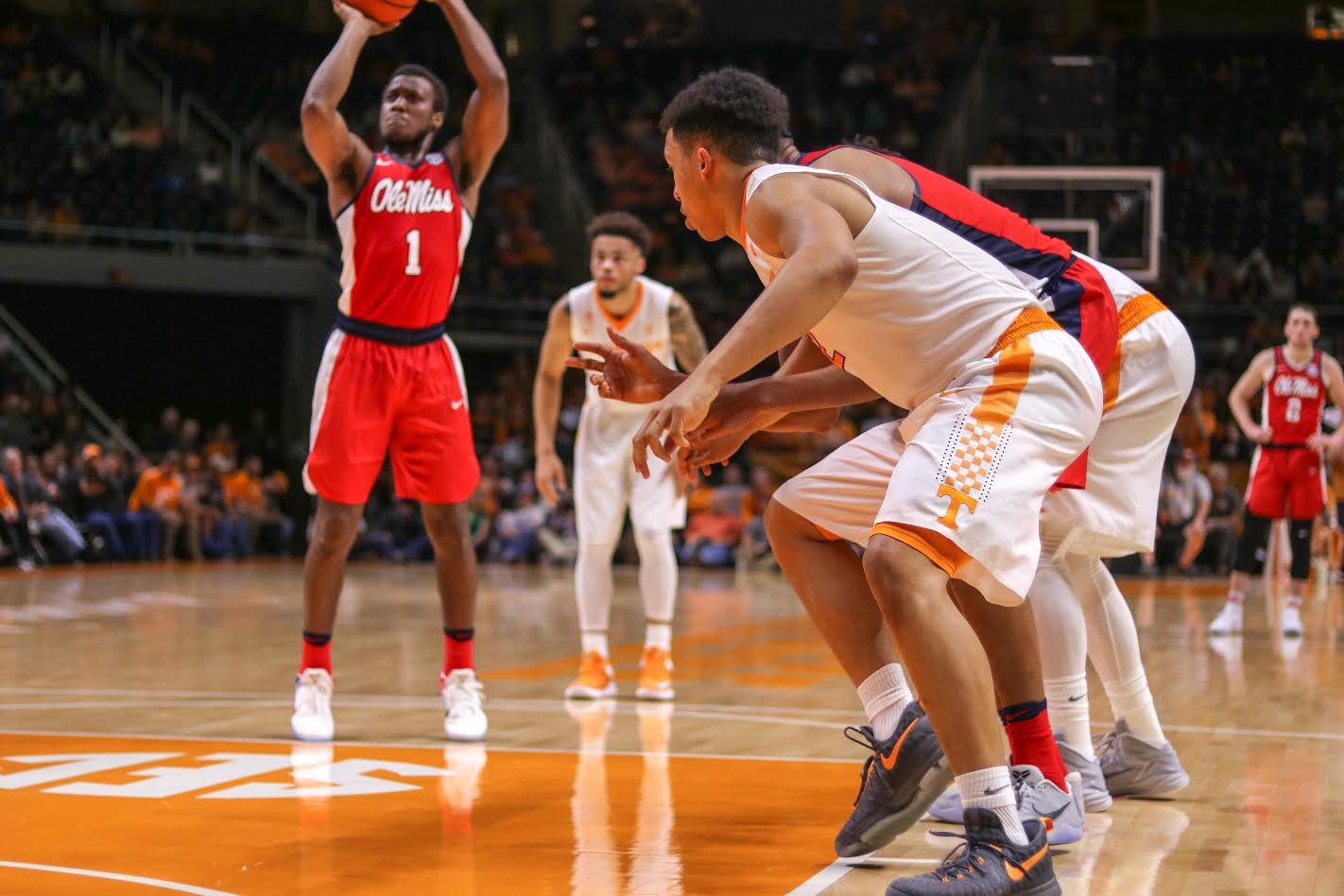Carder: NCAA Tournament is proof the SEC was better than given credit for
After sending three teams to the Elite Eight, it’s time to appreciate the SEC has a respected (dare one say, good?) basketball conference

Tennessee freshman #2 Grant Williams braces to box out an Ole Miss player on a free throw attempt during the Vols' game against Ole Miss on Feb. 8, 2017 in Knoxville.
It’s been almost ten years since the SEC’s been taken seriously. The criticism is warranted given the track record of late. Yet, the current crop of coaches in the rank amongst the best of the Power 5 conferences.
Before the season, there was reason to believe this would be the year the SEC began making a name for itself. At season’s end, eight teams earned a bid to a postseason tournament, five to the NCAA Tournament and three to the NIT.
Thanks to improved efforts on the recruiting trail, the SEC presented a healthy combination of veteran and youthful talent this season. The individual talent and quality of teams helped the SEC produce a more appealing product compared to recent memory. If it weren’t for the conference’s performance in the NCAA tournament, a majority of fans would have failed to recognize this fact.
The SEC sent three teams to the Elite Eight this year. What other conference can say that? Look at it this way, the Big Ten and SEC had three teams left heading into the Sweet Sixteen. One conference went 0-3, the other went 3-0. Unfortunately, the tendency to stick to the common narrative results in a number of doubters in the SEC to remain skeptical.
South Carolina’s rough finish to the season led to them being under-seeded in the tournament. After beating Duke, Baylor and Florida en route to its first trip to the final four, South Carolina reminded college basketball why they were a Top 25 team for a majority of the year. The Gamecocks are a better team than their place as a seven seed indicated, and they’ve proven that during their run. As for Florida and Kentucky, those deep tournament runs should have come as a surprise to no one. When was the last time the top three teams in the SEC were this good? It’s been a few years, at least.
A main reason why there seems to be a lack of appreciation for the SEC throughout the regular season is due to the strong defensive play. Fans enjoy scoring, which is understandable. With that being said, the SEC was the best conference defensively all year.
To explain this, advanced analytics will be brought into the discussion using KenPom’s rankings. His adjusted offensive and defensive efficiency calculations and adjusts it based on team’s opponents.
For instance, the SEC holds four of the top 10 spots in KenPom’s adjusted defensive efficiency rankings (South Carolina 2nd, Florida 5th, Kentucky 7th, Alabama 10th). Beyond that, Vanderbilt (36th), Georgia (42nd), Texas A&M (53rd) and Tennessee (55th) gives the SEC nine teams in the Top 55 in terms of KenPom’s defensive efficiency ratings, which led all Power 5 conferences.
As for SEC teams such as Arkansas, the offense served as the team’s primary strength, proving that the conference was more than just a couple good defensive teams. Scoring around 80 points per game, the Razorbacks nearly knocked off North Carolina in the Round of 32 after making it to the SEC Championship game. Going into the tournament, Arkansas ranked 25th in terms of RPI.
In addition, both Auburn (80 points per game) and Ole Miss (78 points per game) posted respectable offensive numbers. Auburn’s freshman point guard Mustapha Heron (15.2 points per game) is a future star for the SEC and made the Tigers a joy to watch despite the team’s inability to defend anybody.
Now these stats don’t tell the whole story, but the defensive numbers specifically should paint a picture for the unpopular style the SEC used during its overall successful 2016-2017 season.
To name some accomplishments: In the fourth season of the Big 12/SEC challenge, the two conference both won five games, marking the first season in which the SEC did not lose the challenge. For the first time since the conference expanded to 14 teams, 12 teams finished the regular season with a winning percentage of at least .500. The SEC sent three teams to the Elite Eight for the first time since 1986.
In addition to the improved quality of play, the individual talent throughout the conference provides another improved element of the conference.
Seniors Sindarius Thornwell (21.6 points per game), J.J. Frazier (18.8) points per game and Yante Mahen (18.2 points per game) ranked as three of the top four scorers in the conference, with Thornwell earning SEC Player of the Year recognition.
As for the underclassmen, freshmen Malik Monk (19.8 points per game), De’Aaron Fox (16.7 points per game) and Heron all scored over 15 a game, while a number of other first-year athletes averaged double digit points. Texas A&M freshman Robert Williams flew up draft boards after a fantastic year, averaging 11.9 points, 8.2 rebounds and 2.5 blocks (second in SEC). Before deciding to return for his sophomore year, Williams was a rumored as a potential lottery pick, joining Monk and Fox as three SEC freshman projected as a lottery pick.
Sophomores Antonio Blakeney of LSU (17.2 points per game) and Mississippi State’s leading scorer, Quinndary Weatherspoon (16.5 points per game), serve as high-volume bucket getters stuck on two of the worst teams in the conference this season.
With a number of exciting players to watch this season and a majority of team’s improving from last season, the SEC proved this season that it’s a conference on the rise. This isn’t to say “Time to call the SEC a basketball conference!” but it is time for the conference to gain some respect. They were a solid basketball conference this season and the stats hint at that fact.
At the very least, it’s time for the classic “The SEC is trash at basketball” comments to vanish. For those reluctant to admit the improved state of the conference, wake up.
Edited by David Bradford
Featured image by Ben Proffitt



